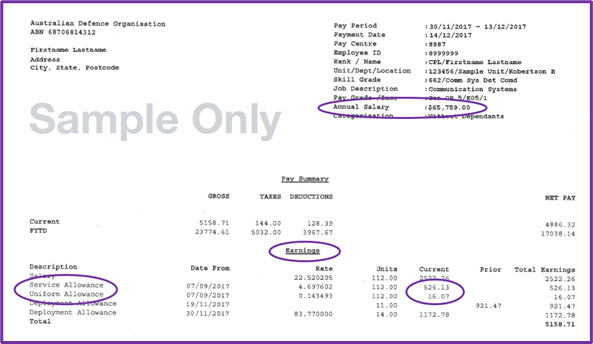INVESTING
Investing is something many Australians believe in—but not always with a clear plan. We will help you think beyond the basics for accumulating wealth, set meaningful financial goals, and create an investment plan that works for your lifestyle and ambitions.
Why Invest Your Money?
Some would say the purpose of investing is to accumulate wealth, but why would we want to do that? As an ADF member, you’re a member of a generous superannuation fund which is investing employer contributions into your account for your retirement. But will your superannuation be enough?
Then there’s your home, if you’re lucky enough to own one. Your home can also be characterised as an investment. If it’s paid off by the time you retire, you may be well set up financially with debt-free accommodation in which to live plus your accumulated superannuation.
Most Australians would be more than happy with that outcome because the reality is that they will be surviving in retirement on either a full or part government age-based pension (trust us, it’s not the road to riches) and will count themselves lucky to have a small amount of superannuation and a mortgaged home. Therefore, looking at your situation from the point of view of less fortunate citizens, a simple portfolio of investments (your superannuation and your debt-free house) may well suit your and your family’s needs.
Should I Bother Investing in Anything Else?
The answer to this question depends on your financial goals. Many people don’t have any financial goals to which they’re seriously committed. As a result, their financial position at retirement is often disappointing (or as they say in financial services industry jargon, “sub-optimal”). That’s a pity because committing early to a set of financial goals and having a plan to achieve them will almost certainly result in a much better outcome.
In the ADF context, this failure is a curious phenomenon because we spend a considerable amount of time making plans, setting goals, undertaking risk assessments and implementing decisions with considerable discipline on behalf of our employer. In fact, many of us are experts at it. But paradoxically, we often don’t do the same thing for ourselves and our families.
Invest For Your Future
For a brief introduction to investing watch our short invest for the future video. From savings accounts to growth assets, learn how investments can play a key role in managing your money.

Investing Quiz
Test your knowledge on the essentials of building an investing plan with this quick quiz! While it doesn't cover everything, your score will give you a solid sense of how well you understand the fundamentals. Whether you're just starting out or brushing up on your skills, this quiz highlights key considerations for ADF members. After completing it, you'll also get access to helpful resources to deepen your understanding and refine your investing strategy.
How to Create an Investing Plan
With a wide range of investment choices available, choosing the right ones for you will depend on your Investing Plan. Different types of investments are more suitable for shorter or longer-term goals.
The investments you choose will need to be appropriate for your:
- Investment goal/s – what are you saving for?
- Time frame – when do you want to reach the goal/s?
- Current investments – are they different from other assets that you own, helping you to lower your risk through diversification across
- Different asset types (aka asset classes)?
- Risk tolerance – do your proposed investments pass the ‘sleep at night’ test?
- How do I set my goals and my timeframe?
Goals must be realistic and achievable
Setting financial goals and a timeframe for achieving them is about clearly stating what you want, when you want it and how much it’s going to cost.
If you set yourself a target of saving, say, $500 a week, but your current budget suggests that only $300 a week is realistic, then you’re setting yourself up to fail. You will need to adjust your goal, the time frame, or both.
If a goal you set will take longer to achieve, it may allow you to choose from a wider variety of suitable investments because you have the time to ride out the short-term ups and downs (aka volatility) of investment markets to achieve better long-term returns.
Should I Diversify My Investments?
Diversification is about managing the risk/reward trade-off by selecting a mix of investments to help you achieve more consistent returns over time.
Different investment markets peak at different times, so limiting your exposure to a single asset class will reduce your risk of a large loss in any given year.
Therefore, before you take on a new investment, consider what you already have and ask yourself whether the new investment will diversify your position and therefore lower your overall investment risk.
Assets that carry a higher risk usually deliver a higher return over the long run, but are likely to have more volatile returns over the short term. You can offset some of this risk and volatility by including assets in your portfolio that have lower short-term volatility, and lower risk, but also lower returns.
As well as diversifying across asset classes, you could also consider diversifying within asset classes. For example, a share portfolio may include shares in companies from different industries such as mining, banking, consumer goods and healthcare. Or you might keep it simple and invest in a publicly available diversified share fund.
Investment types
The investment you choose might be determined by how long your money will be invested, your willingness to take on risk for potential higher returns, and your personal preferences. Here’s what you need to know.
Options for short to medium-term savings
Long-term growth and rental income opportunities
Understand the importance of diversification, and choosing the right platforms
Pool your money to access professionally managed portfolio
Investing in art, coins, stamps, antiques, classic cars
Understanding how to buy, sell, and protect these unique and often volatile investments.
What’s Your Risk Tolerance?
In the long term, so-called growth assets, like shares and property, will usually outperform an income asset, like cash, by a considerable margin. However, in the short-term, growth asset markets can be quite volatile. This can cause investors to get “cold feet” about their investing plans. We saw this phenomenon during the global financial crisis in 2007-8 when understandably worried investors sold their share portfolios at historically low prices, only to find that the market eventually rose to its previous position and higher.
Your risk tolerance reflects your ability to cope with dips in the value of your investments. Any investment you make needs to pass the ‘sleep at night’ test. If the risk worries you to the point of not being able to sleep, the investment is not for you.
Always choose investments you understand and are comfortable with, even if this means having to adjust your goals or the time it will take to achieve them. Keep in mind that dips in the market only represent a theoretical loss, until you sell an investment and crystallise the loss. The same goes for increases in value. Gains are not permanent (or in investor jargon, realised) until you sell the investment.
Frequently Asked Questions
- Pay off any high-interest debt
- Set aside emergency savings
- Protect your valuable possessions with insurance
- Consider whether you need personal insurance coverage
- Think about why you want to invest (what’s the purpose and timeframe?)
- Your financial goals and when you'll need the money
- How comfortable you are with market ups and downs
- Whether your plans might change and you'll need flexibility
Helpful Resources
Visit MoneySmart and read their article on Developing an Investing Plan
Read our Financial Advice guide to learn about the process of Getting Financial Advice and understand what to expect.
You might like to consider seeking the services of a licensed financial adviser to help you in developing your financial goals and investing plan.
Investing Checklist
- Carefully consider the principal factors that go into creating an effective Investing Plan
- Do your budget so you know how much you can afford to invest
- Set your goals and a realistic timeframe
- Cost it out so you know your regular commitments
- Think carefully about diversification in your portfolio
- Consider how any new investments will complement your existing investments
- Think about how/whether you can tolerate market volatility, especially if you are contemplating borrowing money to invest (which unavoidably increases your risk).







